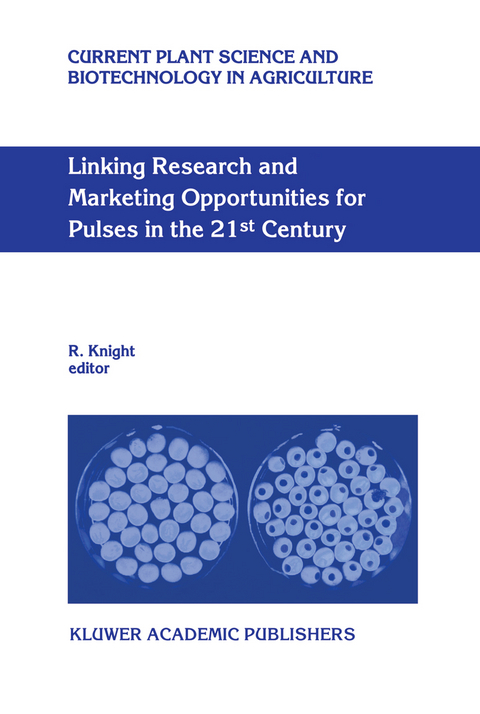
Linking Research and Marketing Opportunities for Pulses in the 21st Century
Proceedings of the Third International Food Legumes Research Conference
Seiten
2012
|
Softcover reprint of the original 1st ed. 2000
Springer (Verlag)
978-94-010-5884-1 (ISBN)
Springer (Verlag)
978-94-010-5884-1 (ISBN)
Proceedings of the Third International Food Legumes Research Conference
Food legumes (pulses) playa role in human nutrition and more recently as animal feed, in the developing world. They contain minerals and vitamins essential for a balanced diet in humans. In many developing countries food legumes provide the necessary protein and amino acids (in predominantly vegetarian India, Bangladesh, Nepal, Myanmar and Sri Lanka) and supplement the protein diet of people in other countries. Since 1980-82 per capita consumption has declined by 6 % in developing countries where relative pulse prices have gone up and consumption of animal protein (eg milk) has increased. The importance of legumes as animal feed is increasing. The compound growth rate for feed use during 1980-95 was 7. 97% compared to 1. 5% growth for food use during the same period (Kelly et aI. , 1997). As an integral part of farming systems, food legumes, in rotation with cereals and tuber crops, assist in maintaining soil fertility and the sustainability of production systems (Rego et aI. , 1996). Owing to higher prices in comparison with cereals, food legumes are increasingly being grown to supplement farmers' incomes.
The major food legumes grown in developing countries are: dry bean (Phaseolus vulgaris), faba bean (Vicia faba), dry pea (Pisum sativum), chickpea (Cicer arietinum), lentil (Lens culinaris), mung bean (Vigna radiata), black gram (Vigna mungo) pigeonpea (Cajanus cajan) and Lathyrns ( Lathyrus sativus). Oil crops such as groundnut (Arachis hypogaea) and soybean (Glycine max) are food legumes but are not discussed in this paper.
Food legumes (pulses) playa role in human nutrition and more recently as animal feed, in the developing world. They contain minerals and vitamins essential for a balanced diet in humans. In many developing countries food legumes provide the necessary protein and amino acids (in predominantly vegetarian India, Bangladesh, Nepal, Myanmar and Sri Lanka) and supplement the protein diet of people in other countries. Since 1980-82 per capita consumption has declined by 6 % in developing countries where relative pulse prices have gone up and consumption of animal protein (eg milk) has increased. The importance of legumes as animal feed is increasing. The compound growth rate for feed use during 1980-95 was 7. 97% compared to 1. 5% growth for food use during the same period (Kelly et aI. , 1997). As an integral part of farming systems, food legumes, in rotation with cereals and tuber crops, assist in maintaining soil fertility and the sustainability of production systems (Rego et aI. , 1996). Owing to higher prices in comparison with cereals, food legumes are increasingly being grown to supplement farmers' incomes.
The major food legumes grown in developing countries are: dry bean (Phaseolus vulgaris), faba bean (Vicia faba), dry pea (Pisum sativum), chickpea (Cicer arietinum), lentil (Lens culinaris), mung bean (Vigna radiata), black gram (Vigna mungo) pigeonpea (Cajanus cajan) and Lathyrns ( Lathyrus sativus). Oil crops such as groundnut (Arachis hypogaea) and soybean (Glycine max) are food legumes but are not discussed in this paper.
The Global Picture. Regional Reviews. Research to Meet Quality Demands of the Market. Enhancing Yield Potential and Quality. Marketing Opportunities - Regional Trends in the Supply and Demand for Pulses. Adaptation to the Environment. Marketing Opportunities - Regional Trends in the Supply and Demand for Pulses. Farming Systems and Management. Biotechnological Interventions. Integrated Pest Management. Marketing Opportunities - New Market Uses for Pulses. Lessons from Lupins. Germplasm and Biodiversity. Nutritional Value in Food and Feed. Conference Summaries.
| Reihe/Serie | Current Plant Science and Biotechnology in Agriculture ; 34 |
|---|---|
| Zusatzinfo | XIX, 707 p. |
| Verlagsort | Dordrecht |
| Sprache | englisch |
| Maße | 160 x 240 mm |
| Themenwelt | Naturwissenschaften ► Biologie ► Botanik |
| Technik ► Lebensmitteltechnologie | |
| Weitere Fachgebiete ► Land- / Forstwirtschaft / Fischerei | |
| ISBN-10 | 94-010-5884-9 / 9401058849 |
| ISBN-13 | 978-94-010-5884-1 / 9789401058841 |
| Zustand | Neuware |
| Haben Sie eine Frage zum Produkt? |
Mehr entdecken
aus dem Bereich
aus dem Bereich
Gefäßpflanzen: Grundband
Buch | Hardcover (2021)
Springer Spektrum (Verlag)
CHF 62,95
ein Baum erzählt seine erstaunliche Geschichte
Buch | Hardcover (2024)
Ludwig (Verlag)
CHF 32,15


